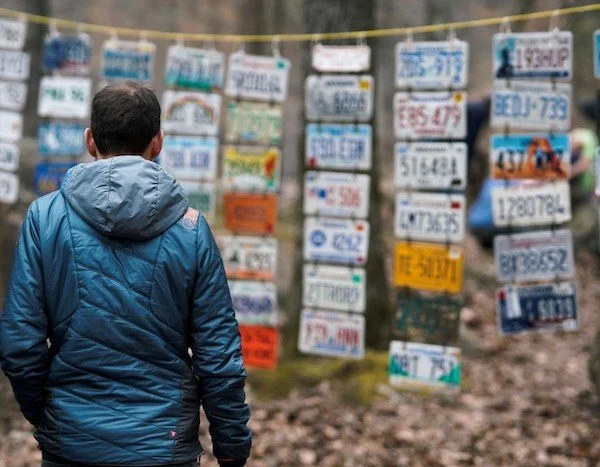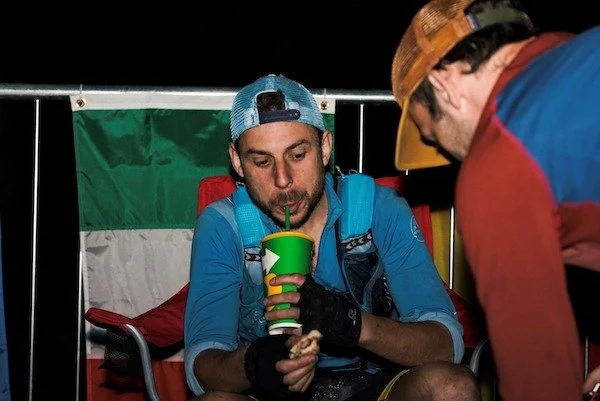Barkley James Hardest
As most of the ultra community will know, the Barkley Marathons is a truly special, one-of-a-kind event that happens in Frozen Head State Park, Tennessee around April Fool’s weekend each year. This was the 34th time the event was held and the first time I had been out to the race. I, along with 39 other incredibly fortunate runners, were set to take on the five x ’20 mile’ loops, each with around 14,000ft of climb (and descent), largely off-trail and self-supported. Once a runner leaves on a loop they may accept no aid or help whatsoever, except from other runners. New for this year, RD Laz banned electronic equipment of any kind other than a headlamp.
As he says, this is a test of man against the wilderness. No help is coming.
The race is somewhat shrouded in mystery, with no website and with course/entry details remaining somewhat secret. Runners respect the stipulations of being a Barker. I won’t share anything on those subjects, but I did want to share something about what makes this such a special race, why the community is so strong here and why Frozen Head State Park is a special place.
Image: La Sportiva
Having learned I was one of the lucky 40 starters for 2019, I made preparations in the UK for specific training. A hard thing to do when one cannot see any images of the course or gain a true idea of the terrain. We also live in flat south-central England – so the majority of my conditioning came via climbing and descending short, steep climbs in the woodland over at Wendover in Buckinghamshire. Wendover has a western flank that falls approximately 300 feet in 0.3 miles, and for sessions I would repeatedly climb and descend that area for up to seven hours at a time, clocking up a handful of sessions measuring just 13 miles with 10,000ft of climb and descent in a kind of time trial fashion. One more substantial run in the Lake District allowed me to tip the scales at 100,000 feet of climb in the 25-day peak training block I had set myself as a target. This proved to be adequate training somewhat surprisingly, as I felt physically very strong during this year’s Barkley event.
I got used to going out in the wet, deliberately picking days with poor conditions to test gear and footwear. Kit-wise I really got things dialled in because realistically a loop could last anywhere up to 20+ hours, in the mountains, in conditions that could range across pretty much anything.
One of the challenges one faces at the race is director Laz and his mind games. From the very start of the application process through to the end of the race, he is working away to mess with your head as a runner.
One of the ways he does this is by not sharing when the start will be. There is a 12-hour window during which he gives runners just one hour of warning that the race will begin. He does this by blowing a conch shell, and he blew this year at 8.23am so we got set for a 9.23am start. We all got ready and amassed at the start line. Part of the challenge of the Barkley loop is finding books that Laz has placed around the course as unmanned checkpoints. They ensure each runner has traversed the actual route -– when there are no markings to follow. In this area, veterans to the race have a significant advantage in that many of the book placings remain the same year on year and they are therefore able to find the books more easily on the whole. ‘Virgins’ – or new runners, which referred this year to roughly half of us – often try to tag along with a veteran in order to gain a navigational advantage. I had thought beforehand that it would be great to hang out with, say, John Kelly or Jared Campbell, who know the course better than anyone, but reality is that these guys are running at a really high level and imploding by trying to stick with them would be a fool’s endeavour. I also wanted to be responsible for my own race.
Image: La Sportiva
So we set off up the first climb and I made sure to keep referencing map and compass along with the written instructions. Over the first half of the loop we got to see some incredible climbs and descents, not least the newly added section for this year – the Meatgrinder.
I was partially alone and sometimes with others. But as we neared the mid-point I was caught from behind by
a returning runner, Jodi Isenor. He was gracious enough to work with me and US 24hr-team runner Steve Slaby through the remainder of the loop. His knowledge was invaluable. It was surreal and somewhat dreamlike to be climbing ‘Rat Jaw’ through the saw briers to reach the fire tower. To traverse under the prison through the waterlogged pitch-black tunnel. And to experience just how steep some of the ground could be -– Leonard’s Butt Slide/Fykes Peak ascent which as an out-and-back featured 1,300ft of loss (and then gain) in a 0.3 mile distance. Every climb and descent has a name at Barkley, and Jodi helped us piece them together: Check Mate Hill, the Meatgrinder, Hillpocalypse, Leonard’s Butt Slide, Little Hell, Rat Jaw, The Bad Thing, Zipline, Big Hell.
The course was everything I had hoped for and more. Little Hell, in particular, was a part of the course that had been reinstated after a number of years. It was an intense climb past the open mine shafts that Laz has told us to watch out for, lest we fall in – we would certainly not be coming back out, coal just littering the incredibly steep hill side. The book at the top was right at ’Sawbrier Point’. The 10.5 hours it took me to complete a loop were probably the most memorable hours I have ever had while running, everything was heightened and having forgotten to take the free watch from Laz I simply just didn’t know or care about anything other than going as fast as we could without making mistakes. We made no navigational errors during loop one. On the final climb up Big Hell we were joined by Jared Campbell – the only three-time finisher of the race – who had injured his ankle badly on the first descent but had struggled on using his poles as crutches to make it around a complete loop. To share the trail and some stories with him was a dream come true. He was extremely gracious given the disappointment of what had happened to him.
A quick transition was required between loops in order to make it out with as much time to spare and I got away with 10:58 elapsed. My crew of two, Drew Sheffield and Jack Atkinson, made that possible, though it seems crazy to have a crew for 10 minutes in each half-day period.
I left for loop two with Steve Slaby and Paul Giblin. We were then caught by Gavin Woody, a strong Canadian runner, and we found a lost French runner, Rémy Jegard, a four-time Barkley veteran, on top of the first climb. We proceeded on, and somewhere between books one and two the heavens opened, the wind came in, the temperature plummeted (it was around 20 degrees C all day and dropped overnight to -5) and extremely heavy rain came dumping down. It caught us unawares; given that it had been hot all day we were carrying lightweight gear at the time and so largely underprepared for these new conditions that really required full mountain equipment. Within an hour or so my hands quickly became useless and the possibility of an accident on such severe terrain when already being dangerously cold was simply too much of a risk to warrant continuing on.
Image: La Sportiva
I wasn’t 100% sure of the decision at the time, but asn I turned and began navigating back to camp it became obvious that I had made the right decision. The rain turned to sleet, and the fog blew in so that it became literally impossible to see more than a step at a time. Rémy and I made it back to camp, and Laz greeted us with taps and consolation. It felt like defeat. The weather was not unusual, or particularly bad for Frozen Head, we just did not prepare for it as newcomers. All five of my group on the second loop came back within the space of a few hours.
Of the 40 starters, 28 finished under the loop one cut-off and 22 of those made it out on to loop two. Only six runners made the loop two cut-off and each of those went on to finish a legal Fun Run – three loops in under 40 hours. Two runners began loop four but did not complete the lap. Karel Sabbe, the Appalachian Trail record holder, made it the farthest this year, getting three books in to loop four before abandoning, unable to find that location. As in 2018, the 2019 race had no finishers.
Much of this story might read like lunacy. Some people would probably question the point of a race which is set up for there to be no finishers, most years. But as veteran David Horton says, the point is that it is right out there on the edge of possibility. Someone can and will finish this course again one day. They must be in exceptional physical shape. Be willing to put themselves in a horrible place for days on end. To have that deep need to finish. To be a competent navigator, to be self-sufficient, handle extreme sleep deprivation and be able to focus when the brain is calling for nothing but for you to stop.
And to be able to deal with the puzzle that is the Barkley Marathons.
One thing is for sure, this race gets under your skin and the sense of camaraderie and community has never been stronger at any event I have been to before. I hope one day to return.
My thanks to Drew and Jack for the crewing and for La Sportiva and Petzl for their support through everything.
—
James began running ultras in 2006 and has completed many of the prominent global ultras including Badwater, Spartathlon, Western States, Leadville etc. He has represented Team GB twice at the 24hr format. In the UK he began organising events in 2011 and has so far directed over 50, 50- and 100-mile trail ultras through Centurion Running. He has been coaching athletes for ultra distances since 2012.
Main image: La Sportiva
Image: La Sportiva



